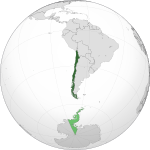Portal:Chile
{{Wikipedia:WikiProject Chile/Tab header}}
Chile, officially the Republic of Chile (Spanish: <phonos file="RepChile.ogg">República de Chile</phonos>), is a country in South America occupying a long and narrow coastal strip wedged between the Andes mountains and the Pacific Ocean. The Pacific forms the country's entire western border, with Peru to the north, Bolivia to the northeast, Argentina to the east, and the Drake Passage at the country's southernmost tip. Chile claims 1,250,000 square kilometres (480,000 sq mi) of territory in Antarctica.
Lua error in package.lua at line 80: module 'Module:Box-header/colours' not found.
The Andean Condor (Vultur gryphus) is a species of South American bird in the New World vulture family Cathartidae and is the only member of the genus Vultur. Found in the Andes mountains and adjacent Pacific coasts of western South America, it has the largest wing span (at 3.2 m) of any land bird. The Andean Condor is a national symbol of Argentina, Bolivia, Chile, Colombia, Ecuador and Peru. It is the national bird of Bolivia, Chile, Colombia, and Ecuador. The Andean Condor can be found all over the Chilean cordillera from Parinacota to Torres del Paine National Park.
Lua error in package.lua at line 80: module 'Module:Box-header/colours' not found.
Isabel Allende Llona, (born 2 August 1942), is a Chilean novelist. Allende, who writes in the "magic realism" tradition, is considered one of the first successful women novelists in Latin America. She is largely famous for her contributions to Latin-American literature, novels such as "The House of the Spirits" and "City of the Beasts", which have been hugely successful. She has written novels based in part on her own experiences, often focusing on the experiences of women, weaving myth and realism together. She has lectured and done extensive book tours and has taught literature at several US colleges. She currently resides in California along with her husband, having adopted American citizenship in 2003.Lua error in package.lua at line 80: module 'Module:Box-header/colours' not found.
- ...that Ojos del Salado is the highest mountain in Chile and the highest volcano in the world?
- ...that the Chinchorro mummies are the oldest examples of mummified human remains, dating to thousands of years before the Egyptian mummies?
Template:/box-header Template:/Categories Template:/box-footer
- What are portals?
- List of portals
- Featured portals






